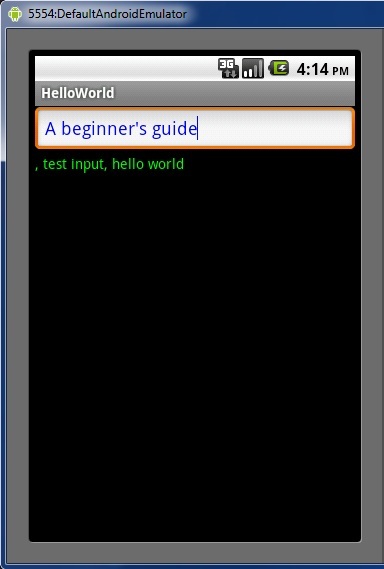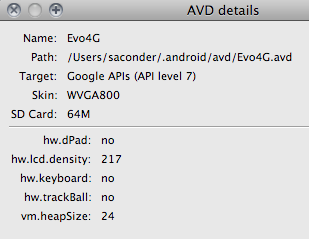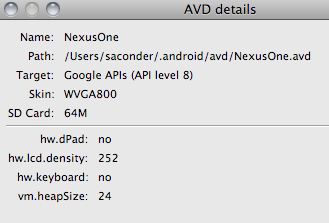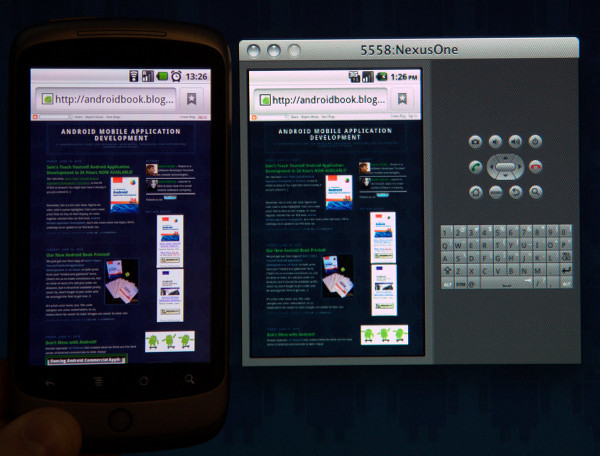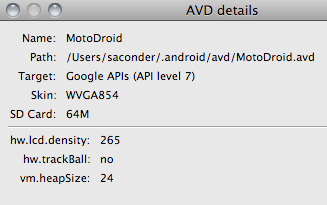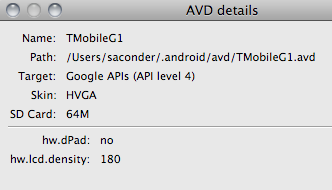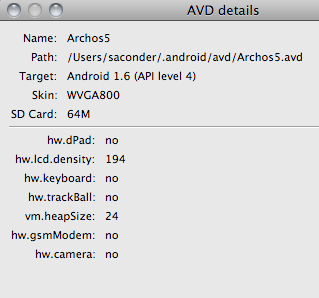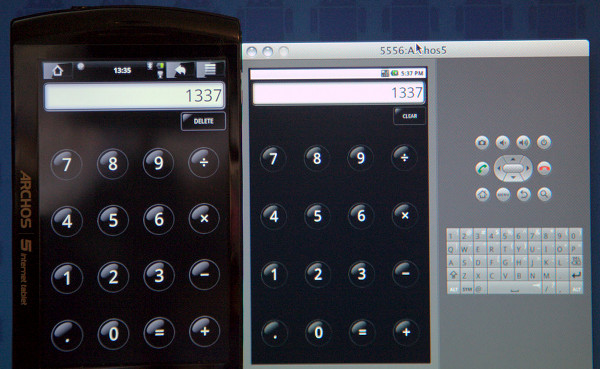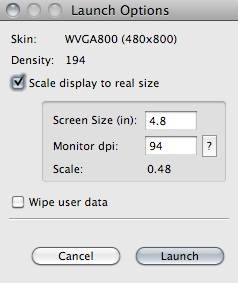Now we want to create our first application, which is (as always) a Hello World application. First of all, start Eclipse. Then select "File/New/Project". In the "New Project" dialog, select "
Android/
Android Project" and click "Next".
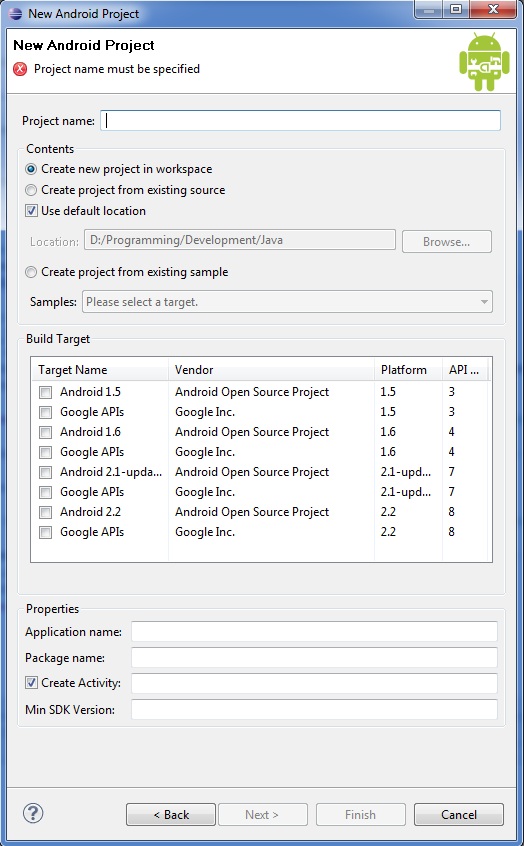
Here you can set up the project. First of all, we need to give the project a name, so type "Hello World" in the name box. Next you have to select the
Android version you want to use. Here we choose version 2.2. As we see in the last column, we need the API Version 8 for this
Android version, so we type an "8" in the Min SDK Version box. Also, the project requires an application name. (Notice that this name is also used in code, so the name should have no whitespaces). Usually, you use the project name and delete all whitespaces (e.g., "helloworld" for this project). Next, you have to define the package of the project. We will use "com.test.helloworld" here (a package can group multiple classes; for more information, see
here). At least, you need a name for the activity (one App might have multiple Activities; they are like a single part/screen of the app). In this example, we simply use "HelloWorldApp".
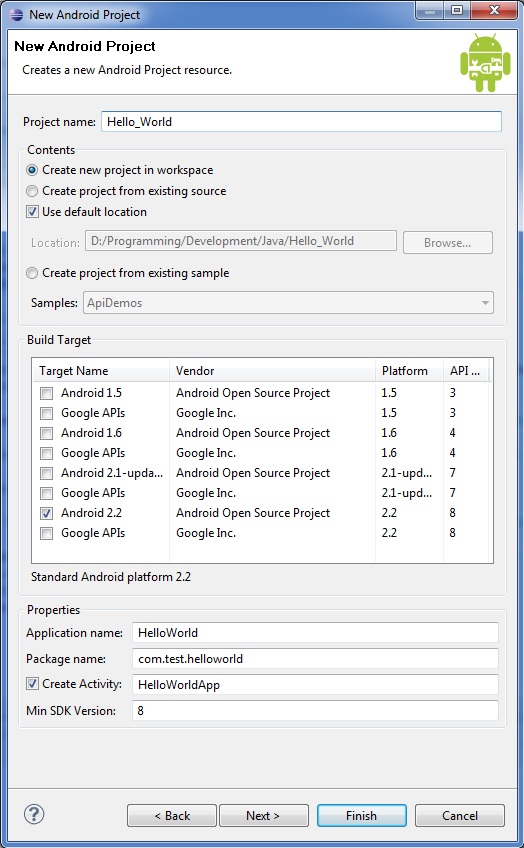
Before we can finally start our first project, we need to create a configuration. This configuration specifies under which circumstances the app will be started. E.g., you can control the network speed the emulator/app can use. Also, you can choose different emulators to test the app with different versions of
Android or in different screen sizes. To create the configuration, go to "Run/Run Configurations". Now click the "
Android Application" tab at the side and then the New button above the tabs. Call the new configuration "HelloWorldConfig" and select our project over the Browse button. Now move on to the target tab. Here you can select the network speed and which emulator will be used.
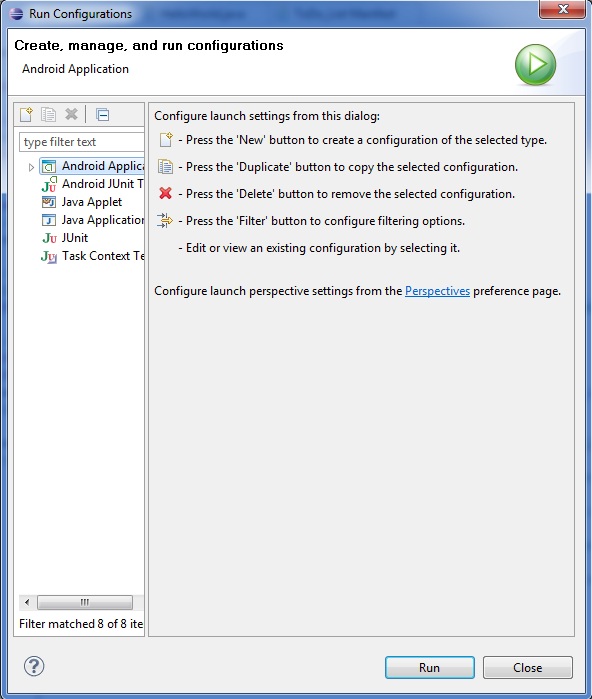
Since we haven't created an emulator till now, we need to do that first. Click the automatic control to enable the buttons at the side and then click on the manager-button. Here, click the new button to the right to create a new emulator. In the following screen, you can enter a name for the emulator (I have used "Default
AndroidEmulator") and specify the details (like
Android version, SD card size, and much more). You can control every little detail of the emulator over the hardware section.
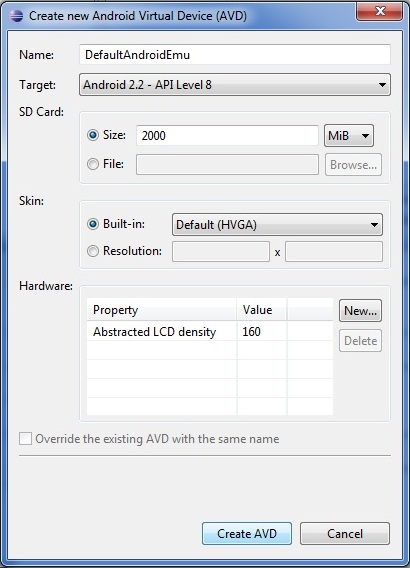
Once you are done with that, click "Create AVD" and close the manager window. Now we have successfully created the run configurations. Click "Apply" and close the configurations. At least run your first
Android project.
Notice: It may take the emulator some time to get started, so be patient! Also, I have cropped the image so that you can't see the keyboard or the D-pad.
Congratulations! You just created your first App!
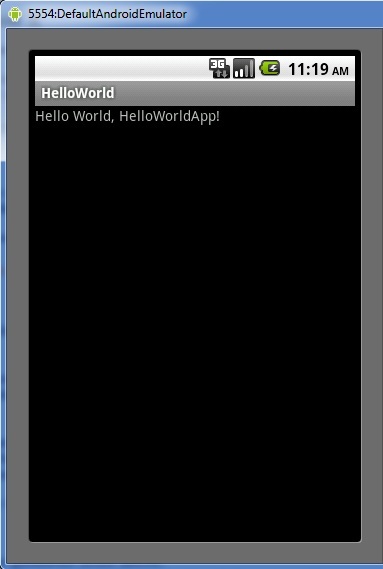
Coding is Fun
After we have set up everything, it's (finally) time to actually getting started with the code, because we all know: Coding is fun!
But before we can actually jump into the Java code, we need to understand the structure of an
Android Application. Go to your Package Explorer and enlarge the "Hello World" project. You will see five folders and two files. Let's get started with the one of these two files, the
AndroidManifest file. This file contains all the information about your project, like the icon, the name of the author. To open it, make a right click on it and choose "Open With/
Android Manifest Editor". In the upcoming tab, you can specify the package name and the version of your project. At the bottom, you will find additional tabs. I think most of the settings you will find are pretty much self-explanatory. Note the @ in front of some attributes. This shows that the following string is a reference to a resource. You can find the resources in the "
res" folder of your project. If you enlarge it, you will notice that it has some subfolders. To be specific, the
res folder can have seven types of subfolders:
values,
drawable,
layout,
animations,
xml,
styles, and
raw.
Let's focus on the
values folder first. Here you can store all kinds of simple resources (like strings, colors, numbers, dimensions, arrays, etc.). By default, you will find the
strings.xml file in there. When you open it (with right click, "Open with/
Android Layout Editor"), you will see that it contains two values. The first is the message you see when you run your project, and the second is the name of your app. You can add new values if you want to use them later on in code (or in the Manifest or Layout files). You can also create specific resources using quantifiers. If you add a - to the folder's name, you can add a quantifier to the name. E.g., you can rename the
values folder to
values-en which means that the content of the folder is only used by
Android phones with English language activated. If you do not add a quantifier, the resources are default. The default resources are used if no specific resources for the current system are found. If the project is started, all resources will be compiled as efficiently as possible and added to the package. Also, a reference will be created (called R) which allows you to access the resources in code. Since this is only a
tutorial, I will not focus on all the types of resources here. You can find more information on resources and quantifiers
here.
At last, it is time to start coding! Go to the "
src" folder. In the folder, you will find the package folder, open the
HelloWorld.java file. You will see the default code for an
Android Activity:
 Collapse
Collapsepackage com.test.helloworld;
import android.app.Activity;
import android.os.Bundle;
public class HelloWorldApp extends Activity {
@Override
public void onCreate(Bundle savedInstanceState) {
super.onCreate(savedInstanceState);
setContentView(R.layout.main);
}
}As you can see, we create a new activity by extending the default
Android activity class. Then we override the default
onCreate function, which is called when the project is created. In there, we load our own layout from the resources and also call the
onCreate function of the base class. Now let's take a closer look at the layout file. You find it in the layout folder under resources. When you open it, it should look like this:
 Collapse
Collapse<linearlayout android:layout_height="fill_parent"
android:layout_width="fill_parent" android:orientation="vertical"
xmlns:android="http://schemas.android.com/apk/res/android" />
<textview android:layout_height="wrap_content"
android:layout_width="fill_parent" android:text="@string/hello" />
</linearlayout />You see the root node is called
LinearLayout. As you you might already have figured out, there are different types of layouts:
FrameLayout: All controls (children) are placed in the upper left corner.LinearLayout: All children are positioned in vertical/horizontal order.RelativeLayout: The positions of the children are specified in relation to the other children.TableLayout: The child elements are placed with a grid.AbsoluteLayout: The child elements are positioned based on absolute coordinates (in pixel).
Once you have chosen a layout type, you can add child elements. In the code given, there is already a
TextView, which is used to display text on the screen. The current content is a reference to a resource defined in the
values.xml file. As you will see, it uses the whole width of the screen, but is only as long as it needs to, to display the content. We might start with some small changes. Let's change the text color of the
TextView to green:
 Collapse
Collapse<textview android:layout_height="wrap_content"
android:layout_width="fill_parent" android:text="@string/hello"
android:textcolor="#FF00FF00" />Now, launch the project and see the changes. Next, let's add a new control called
EditText:
 Collapse
Collapse<linearlayout android:layout_height="fill_parent"
android:layout_width="fill_parent" android:orientation="vertical"
xmlns:android="http://schemas.android.com/apk/res/android" />
<edittext android:layout_height="wrap_content"
android:layout_width="fill_parent" android:textcolor="#FF0000FF"
android:id="@+id/et_Text" />
<textview android:layout_height="wrap_content" android:layout_width="fill_parent"
android:textcolor="#FF00FF00" android:id="@+id/lv_View" />
</linearlayout />When we want to access the controls in code, they need to have an ID. Next we create some code for the controls. Go to the
helloworld.java file.
 Collapse
Collapse@Override
public void onCreate(Bundle savedInstanceState) {
super.onCreate(savedInstanceState);
setContentView(R.layout.main);
final TextView tv_View = (TextView)findViewById(R.id.tv_View);
final EditText et_Text = (EditText)findViewById(R.id.et_Text);
et_Text.setOnKeyListener(new OnKeyListener()
{
public boolean onKey(View v, int keyCode, KeyEvent event)
{
if (event.getAction() == KeyEvent.ACTION_DOWN)
{
if (keyCode == KeyEvent.KEYCODE_DPAD_CENTER)
{
tv_View.setText(tv_View.getText() + ", " +
et_Text.getText());
et_Text.setText("");
return true;
}
}
return false;
}
});
}We will analyze the code line by line. First of all, as before, we load the layout. Then we create a
TextView and a
EditText variable and load our interface objects in them (that's what we need the ID for). Finally, we add a new
OnKeyListener to the
EditText control. In this
OnKeyListener, we create the method
onKey, which is called when a key is pressed, when the control is active. In the method, we perform two checks: the first to be sure that a key is pressed down (and not released), and the second to specify the key (in this case, the center key of the D-pad). If both checks are passed, we add the text of the
EditText control to the
TextView, and finally the text of the
EditText control is deleted. Run and test the application. Great, you created your first real
Android app.
